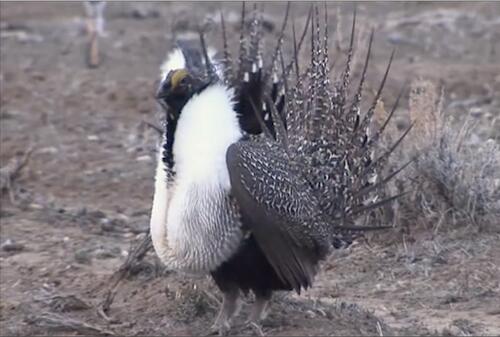
When it comes to impressing the ladies, greater sage-grouse males know that smooth dance moves trump combative posturing. Indeed, new Yale research into these prairie-dwelling birds confirms that female preference is more important than male aggression when it’s time to mate.
During mating season, male greater sage-grouse gather in communal groups called leks. To attract females, they engage in showy dances, strutting around with puffed-out chests and fanned-out tail feathers. They also fight with each other. Some birds are more aggressive, others less so. Researchers have long thought these battles were likely designed to impress female onlookers.
It turns out, however, that female grouse are more interested in the dance displays and are more likely to mate with males who put on a good show.
The findings are published in the journal Proceedings of the Royal Society B.
“The females have evolved to be connoisseurs of these displays,” said Samuel S. Snow, a former doctoral student in Yale’s Department of Ecology & Evolutionary Biology and lead author of the new study. “Females don’t care about the outcomes of the fights. They just want to get back to the displays.”
Snow, who is now a postdoctoral fellow at the University of British Columbia, conducted the research, with ornithologist Richard Prum, the William Robertson Coe Professor of Ornithology of Ecology and Evolutionary Biology in Yale’s Faculty of Arts and Sciences and YIBS faculty affiliate. Researchers from the University of California’s Davis and Irvine campuses also contributed.
In their study, researchers analyzed video of 18 days of greater sage-grouse mating behaviors on the grasslands of Wyoming’s Great Basin region. Their findings reveal that while fighting serves necessary purposes such as defending territory and deterring potential courtship disruptions, it can also hurt a male’s chances of mating. Not only are females unimpressed with aggression, the time males spend fighting also cuts considerably into the time they might otherwise be mating.
“The simplistic correlation between aggression and mating success turned out to be wrong in this species,” Prum said.
The researchers then used a powerful statistical method known as a Relational Event Model (REM) to analyze the birds’ mating behavior. It was the first time REM was applied to animal mating behavior. REM focuses not just on events, but on their order and timing. Whereas other methods used in past research simply counted fights and subsequent matings, and then looked for correlations, REM offers a wider view. It enabled researchers to observe what happens before and after each event.
This approach, applied to detailed observations of the grouse spanning the entire mating season, yielded a more granular, cause-and-effect understanding of how aggression affects mating, Snow said.
For more information, click here for an article published by Yale News or here for the full study in Proceedings of the Royal Society B.



